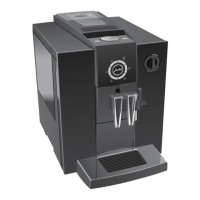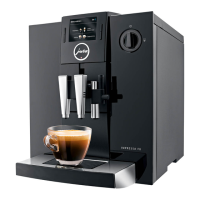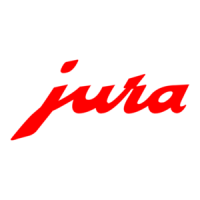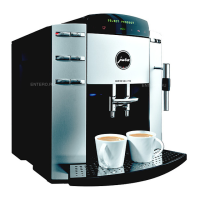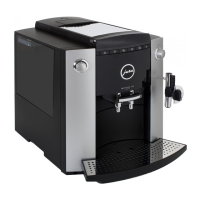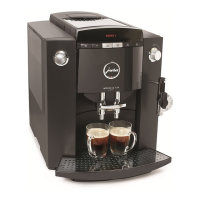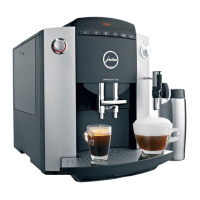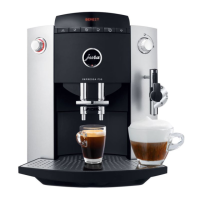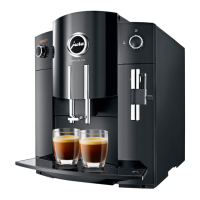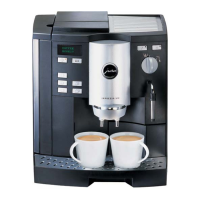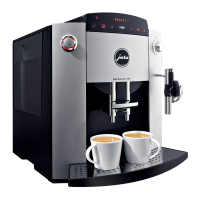
Do you have a question about the Jura IMPRESSA F70 and is the answer not in the manual?
| Type | Coffee |
|---|---|
| Dimensions (WxDxH) | 280 x 445 x 345 mm |
| Product type | Espresso machine |
| Water tank capacity | 1.9 L |
| Coffee beans capacity | 200 g |
| Maximum operating pressure | 15 bar |
| Color name | Platin |
| Cord length | 1.1 m |
| AC input voltage | 230 V |
| Multi beverage | No |
| Cappuccino making | Yes |
| Weight | 9100 g |
|---|
Features like the dialog system, rotary switch, and status symbols for operation.
Buttons for coffee types and aroma settings.
Components for hot water, steam, cappuccino frother, and water tank.
Covers bean tank, grounds container, drip tray, and power switch.
Welcome message and advice on using the manual.
Essential alerts regarding electrical appliances and user supervision.
Guidelines on machine handling, placement, and environmental exposure.
Verifying supply voltage and electrical fuse capacity for safe operation.
Procedures for filling the water tank and connecting to power.
Instructions for adding water and coffee beans.
Adjusting grind settings and powering on the machine.
Setting the preferred language and initial standby mode.
Validating selections using the Rotary Switch for machine operations.
Adjusting water hardness for optimal performance and maintenance.
Information on the advantages of using CLARIS plus filter cartridges.
Step-by-step guide for installing and activating the water filter.
Instructions for replacing the CLARIS plus filter when used up.
Changing the filter without waiting for a display notification.
How the machine performs rinsing when switched off and on.
Performing a rinsing operation without a specific display request.
Customizing the amount of water used for brewing coffee.
Choosing coffee strength and desired water quantity.
Brewing two cups simultaneously with default settings.
Instructions for using the pre-ground coffee funnel, including limitations.
Obtaining hot water for beverages, with safety notes.
Using steam for milk frothing and cleaning purposes.
How to draw off steam, adjust time, and safety precautions.
Preparing milk foam and hot milk for cappuccino using the frother.
Procedure for heating milk using the frother.
Importance and method of rinsing the frother after milk use.
Daily cleaning procedure for the frother and milk pipe.
Steps to safely turn off the machine after use.
Setting up or managing water filter and hardness levels.
Navigating maintenance options and setting aroma intensity.
Adjusting the brewing temperature to HIGH or NORMAL.
Setting the current time for automated functions.
Programming the machine to turn on automatically.
Setting a timer for the machine to turn off automatically.
Tracking the number of coffees brewed for different types.
Changing the display language to English or other options.
Configuring time format and measurement units (ML/OZ).
Steps to safely exit all programming menus.
Daily care for the water tank.
Procedures for removing used coffee grounds and handling the drip tray.
Adding beans and information about filter replacement.
Instructions for the automatic cleaning program.
What to do when the machine indicates calcification.
Best practices for cleaning various parts of the machine.
Draining the system, likely for transport or storage.
Executing the machine's internal cleaning cycle.
Initiating a cleaning cycle manually without a display prompt.
Running the automatic descaling cycle.
Mixing and adding the descaling agent to the water tank.
Performing descaling without a display prompt.
Adjusting the spout height for different cup sizes.
Impact of grind size and preheating on coffee quality.
How additives affect coffee temperature.
Causes and remedies for FILL WATER and FILL BEANS notifications.
Causes and remedies for EMPTY GROUNDS, NO TRAY, and FILTER messages.
Notifications for cleaning, descaling, and general fault handling.
Addressing loud grinding noises and poor milk foam.
Solutions for coffee only dripping from the spout due to grind settings.
Information on copyright, warranty, and legal obligations.
Specifications like voltage, power, dimensions, and EU directives.
